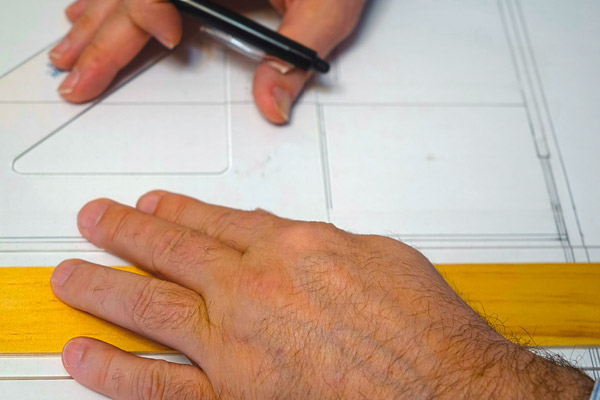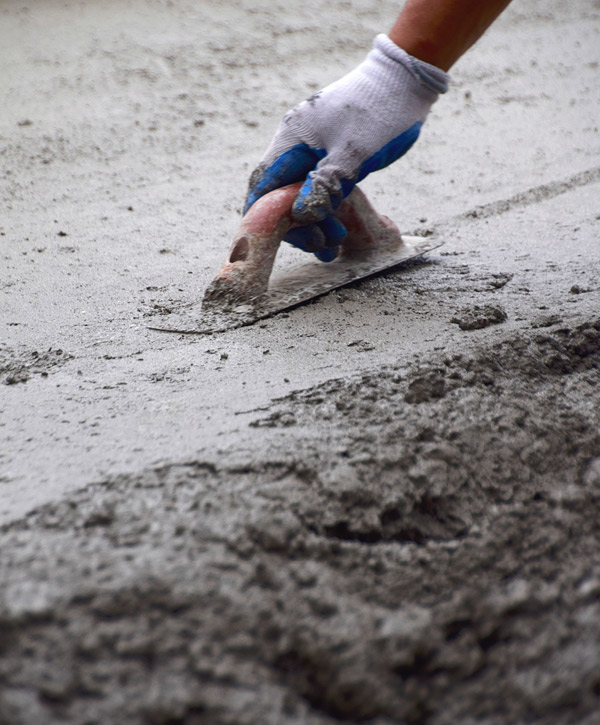
As decorative contractors, we all have our favorite tools in our trusty toolbox. I asked contractors around the country what their “go-to tool” was and I’ve compiled the answers that topped the list. Some are traditional tools, while others are not.
While surveying my peers, I discovered that contractors approach projects differently and require a great variety of tools to get the job done. Perhaps this is why our industry is so innovative and unique.
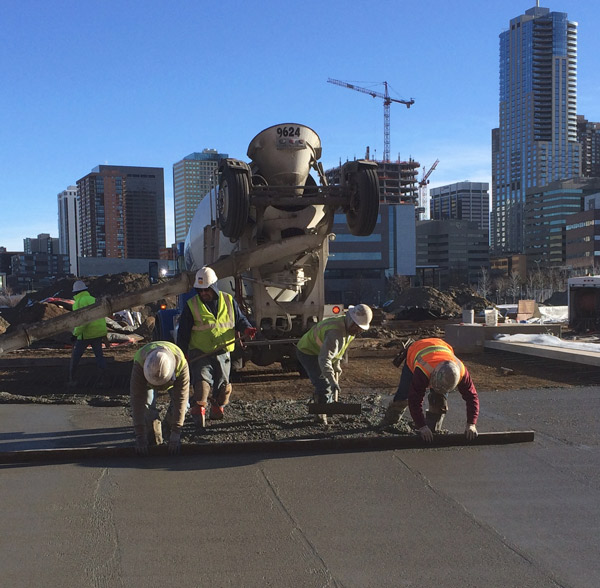
Placement tools
If concrete is not placed properly, the margin for decorative success decreases rapidly from the get-go.
For Lance Boyer of Trademark Concrete in Anaheim, California, the top placement tool is “a roller tamp for top-cast finishes, as it depresses the aggregate enough to yield a consistent sand texture.”
For field operations, Mike Riggs of Progressive Hardscapes in Phoenix, Arizona, swears by the Bunyan Striker, a hydraulic roller screed, while John Parker, a finisher and foreman for Progressive, votes for the magnesium bull float.
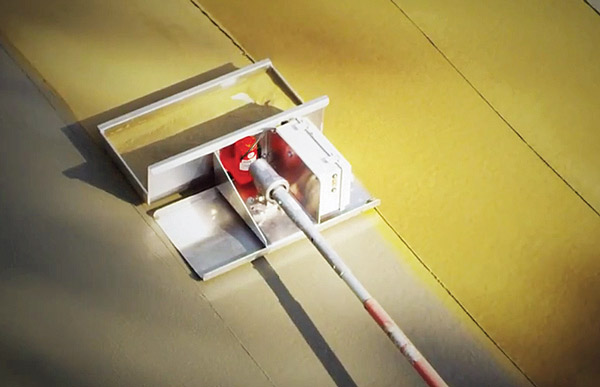
Finishing tools
The types of tools needed for finishing, where the magic takes shape, are as varied as decorative concrete itself.
“A margin/pointing trowel,” says Ryan Lakebrink of Lakebrink’s Custom Concrete in Washington, Missouri, has so many uses like, “working the concrete in tight areas, opening cans of stain and cleanly removing diamonds from a grinder.”
John Fletcher of Carolina Bomanite in Charlotte, North Carolina, prefers imprinting tools, in particular L. M. Scofield’s Used Brick-Basketweave. “We install this as a warning strip at QuikTrip stores.”
Ira Goldberg of Beyond Concrete in Keyport, New Jersey, likes a color hardener spreader. His company doesn’t own one, although he used one at a workshop and appreciated it. “It created an almost carpet-like, even application of color hardener. This tool eliminated the waste and mess that’s created especially on a windy day. It also offers uniformity that’s virtually impossible to duplicate when broadcasting color hardener by hand.”
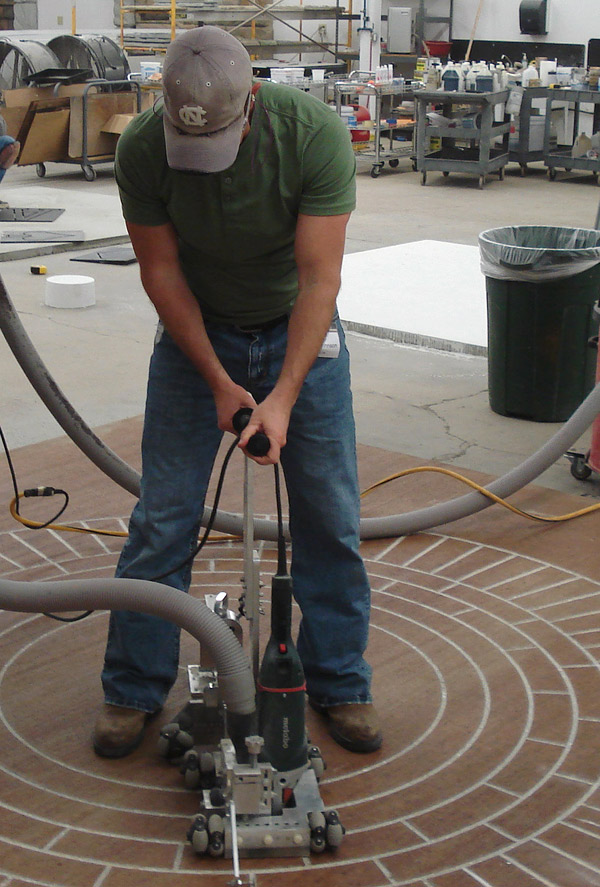
Detail tools
The details in decorative concrete define the craftsmanship and quality. Different types of decorative concrete contractors will use different detailing tools, everything from edge grinders and saws to paint brushes.
“A tool that immediately comes to mind is the Cobra made by Engrave-A-Crete,” says Dan Kroesen of Musselman & Hall Contractors LLC in Kansas City, Missouri. “It’s indispensable when it comes to making intricate cuts, especially when making radius cuts. We use it to prep control joints for joint filler on polished concrete floors.”
Picking a favorite detail tool was tough for Rick Lobdell of Concrete Mystique in Nashville, Tennessee, who doesn’t rely on conventional tools. “What’s important to me is soap stone, a tape measure, a white chalk line (because red is permanent), a square and an angle grinder. I rarely use anything else,” he says, except for a DeWalt angle grinder. “I’ve tried multiple types and I think it is the correct size, build and speed.”
Clearly communicated plans
Without question, a good set of drawings and specifications helps a project go smoothly. Ted Martin, carpenter foreman of Progressive Hardscapes, says, “An accurate set of plans with the correct grades and slopes” is the most important tool on the job site. But it takes more than a good set of prints — it takes clear communication of scope between the bid and the construction.
Progressive’s Riggs says the top tools in his office are “my two large computer monitor screens and on-screen takeoff (software).”
We use a similar system at Colorado Hardscapes, and these tools clearly help identify the scope for both client and crew before any construction. When plans have all the pertinent information needed to bid and build a project, the contractor can focus on the quality and the finishes the decorative concrete requires.
Phone
Electronic devices probably wouldn’t have made the list 10 or 15 years ago. Technology and connectivity have come a long way to help the construction industry.
First, phones help you connect to other industry experts, as Todd Scharich of the American Society of Concrete Contractors points out. “The most important tool to decorative contractors today is their phone. The contractor’s phone gives access to videos, instructions, peers and industry support (DCC Hotline),” he says. “Trial and error will always exist, but educated contractors will use the technology they have in their hand to reduce the errors and open their mind to new methods and means of creating decorative concrete masterpieces.”
Smartphone technology takes the value of phones to a whole new level, says Lakebrink. “We use them for constant communication and to share photos (which are) essential in decorative concrete. The availability and quality of the smartphone cameras are amazing. The ability to access product data from manufacturers online on the job is invaluable.”
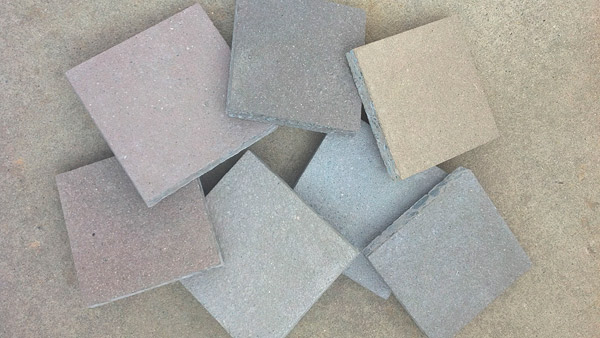
Samples
At Colorado Hardscapes, we strongly believe in samples. In fact, we have dedicated a whole room to display our samples and have a full-time employee working on them daily. Most of our projects are a direct result of a sample or a meeting in our Design Center discussing finishes and samples. Keep some samples in your truck at all times, so you can show them off with no effort.
So without question, “The most valuable tool is our design center and all the samples,” says John Buteyn of Colorado Hardscapes. “I know of no better way to present options to a client and to establish expectations than through samples and mock-ups. This ensures the owners, architects and general contractors, as well as our own crews, know exactly what’s expected.”
Skilled employees
No, I’m not calling employees tools. That’s just rude. But without skilled craftsmen, any tool in your toolbox would be worthless. So, I end this list with some great quotes on the importance of skilled employees.
Boyer says, “A tool in the hands of an experienced craftsman is the best tool.”
“Once the work starts in the field, there are numerous tools needed, but even more important than the actual tools are the craftsmen using them,” says Buteyn. “Experience, expertise and commitment to excellence . . . those things make the difference between a mediocre project and a remarkably good project.”
And lastly, according to Byron Klemaske II of T.B. Penick and Sons: “Smart people that possess expertise, art and skill — find them and invest in them. They will surely make all your tools extraordinary!”
For without great people, all the tools in the world won’t make a difference.



